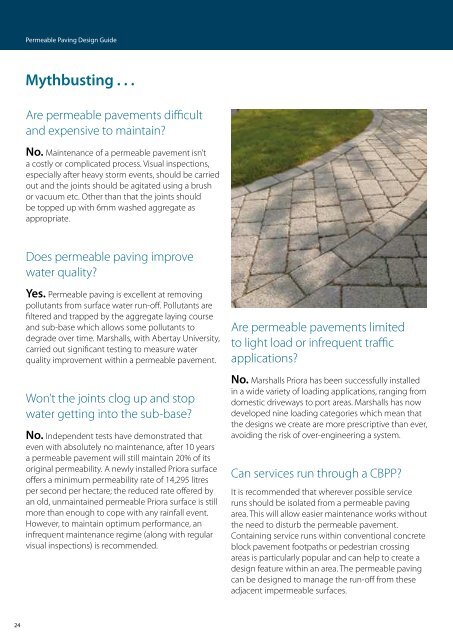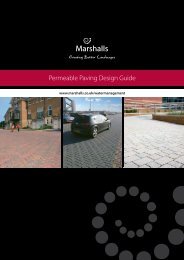You also want an ePaper? Increase the reach of your titles
YUMPU automatically turns print PDFs into web optimized ePapers that Google loves.
24<br />
<strong>Permeable</strong> <strong>Paving</strong> <strong>Design</strong> <strong>Guide</strong><br />
Mythbusting . . .<br />
Are permeable pavements difficult<br />
and expensive to maintain?<br />
No. Maintenance of a permeable pavement isn’t<br />
a costly or complicated process. Visual inspections,<br />
especially after heavy storm events, should be carried<br />
out and the joints should be agitated using a brush<br />
or vacuum etc. Other than that the joints should<br />
be topped up with 6mm washed aggregate as<br />
appropriate.<br />
Does permeable paving improve<br />
water quality?<br />
Yes. <strong>Permeable</strong> paving is excellent at removing<br />
pollutants from surface water run-off. Pollutants are<br />
filtered and trapped by the aggregate laying course<br />
and sub-base which allows some pollutants to<br />
degrade over time. Marshalls, with Abertay University,<br />
carried out significant testing to measure water<br />
quality improvement within a permeable pavement.<br />
Won’t the joints clog up and stop<br />
water getting into the sub-base?<br />
No. Independent tests have demonstrated that<br />
even with absolutely no maintenance, after 10 years<br />
a permeable pavement will still maintain 20% of its<br />
original permeability. A newly installed Priora surface<br />
offers a minimum permeability rate of 14,295 litres<br />
per second per hectare; the reduced rate offered by<br />
an old, unmaintained permeable Priora surface is still<br />
more than enough to cope with any rainfall event.<br />
However, to maintain optimum performance, an<br />
infrequent maintenance regime (along with regular<br />
visual inspections) is recommended.<br />
Are permeable pavements limited<br />
to light load or infrequent traffic<br />
applications?<br />
No. Marshalls Priora has been successfully installed<br />
in a wide variety of loading applications, ranging from<br />
domestic driveways to port areas. Marshalls has now<br />
developed nine loading categories which mean that<br />
the designs we create are more prescriptive than ever,<br />
avoiding the risk of over-engineering a system.<br />
Can services run through a CBPP?<br />
It is recommended that wherever possible service<br />
runs should be isolated from a permeable paving<br />
area. This will allow easier maintenance works without<br />
the need to disturb the permeable pavement.<br />
Containing service runs within conventional concrete<br />
block pavement footpaths or pedestrian crossing<br />
areas is particularly popular and can help to create a<br />
design feature within an area. The permeable paving<br />
can be designed to manage the run-off from these<br />
adjacent impermeable surfaces.<br />
Can Priora be used on sloping sites?<br />
Yes. The interlocking ability of the Priora block<br />
allows installation on sloping sites without the need<br />
for intermediate restraints. The slope will affect the<br />
amount of available storage within the sub-base<br />
and this should be taken into consideration during<br />
design. There are options including baffles and<br />
terracing which will increase the amount of available<br />
storage within the sub-base.<br />
www.marshalls.co.uk/watermanagement<br />
Is permeable paving only effective<br />
on a limited number of ground<br />
conditions?<br />
No. Although a clay subgrade may not be suitable<br />
for a Type A or B system, using Priora may still provide<br />
the most beneficial solution for a site. A correctly<br />
designed Type C system will give a controlled outflow<br />
utilising the storage within the pavement, and it will<br />
still provide the same level of source control and<br />
treatment benefits as you would expect from a Type<br />
A or B system. (See page 34 for information regarding<br />
Type A, B and C systems).<br />
Does the 5m rule used in soakaway<br />
design apply to permeable paving?<br />
No. <strong>Permeable</strong> pavements use dispersed infiltration<br />
across a large area as opposed to standard soakaways.<br />
However, consideration should be taken when<br />
discharging a concentrated volume of run-off, such as<br />
roof water, into a permeable pavement.<br />
Can the hydraulic design be modelled<br />
in Micro Drainage?<br />
Yes. Within the source control section of Micro<br />
Drainage's WinDes®, porous car parks are one of the<br />
storage structures available.<br />
25



